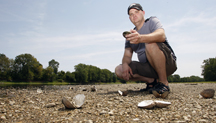Drought has repercussions for Indiana fish and wildlife
August 6, 2012
 |
|
Shells of freshwater clams litter a sandbar in the Wabash
River just north of West Lafayette, Ind. Reuben Goforth, assistant professor of
aquatic ecosystems, says a combination of high temperatures and low water
levels cause the clams to overheat and die. Once the clams are exposed to the
elements, birds and other foraging animals pick the shells clean. (Purdue
Agricultural Communication photo/Tom Campbell) |
WEST LAFAYETTE, Ind. - The drought likely will temporarily alter movement patterns and habitat selection of some Indiana wildlife unable to find food, water and shelter as the resources of their natural environments dwindle, Purdue University wildlife experts say.
Although the impact of the drought on wildlife is unknown at this time, Purdue Extension wildlife specialist Brian MacGowan does not expect lasting effects.
"Most of the things that we will see this year are going to have short-term implications," MacGowan said. "Typically, nature rebounds as long as bad years of weather are followed by good years. However, if the drought resulted in reduced food availability, that will likely result in lower survival of young and weak animals and lower reproduction next year.
"Good weather next year, however, can lead to a good reproductive year that can offset losses from this year."
Two results of the drought - reduced availability of water and poor plant growth - might force wildlife to seek food and shelter in places where they do not usually live, MacGowan said.
Animals that require open water for drinking and reproduction likely will suffer the most, he said. Even animals such as groundhogs, which get most of their water from the vegetation they eat, may be forced to look for open water and may be seen in areas where they are not typically observed.
Conversely, some wildlife could be seen less, MacGowan said. Snakes may change their movements to exclusively nighttime, or salamanders and toads may go underground in response to hot and dry weather. Although frogs and salamanders need wetlands for reproduction, the early spring "jump-started" reproduction in many amphibians.
The drought's most obvious repercussion - reduction or slowing of plant growth - will reduce shelter and food for wildlife. MacGowan said many songbirds nest or forage on the ground or in the shrub layer. Reduced plant growth may result in less protected or concealed nests and reduced fruit production by plants.
Homeowners who have watered fruit-producing shrubs may see more birds this summer and fall as they change movements and habitat to take advantage of available food.
Because the drought is spotty in some areas, it is difficult to determine how it will affect deer, MacGowan said. In areas hit hard by the drought, survival rates among fawns could fall because of reduced summer forage. That, coupled with less fall mast - fruit or seed of woody trees and shrubs - could reduce the survival rate or reproduction among adult deer, especially if there is a harsh winter.
Aquatic ecosystems will feel the impact of the drought as rivers and streams dry up, said Reuben Goforth, assistant professor of aquatic ecosystems. Fresh-water mussels, for example, could become stranded and die. This is a concern because some mussels, including species in the Tippecanoe River, are endangered species.
Even if there is enough water, the ability of a river or stream to hold oxygen decreases as the water temperature increases, Goforth said. Consequently, fish may move to rivers with deeper water.
Although there have not been fish deaths on a large scale, Goforth said there remains a chance that this could happen.
Writers: Abigail Maurer, 765-496-2384, maurer@purdue.edu
Keith Robinson, 765-494-2722, robins89@purdue.edu
Sources: Brian MacGowan, 765-647-3538, macgowan@purdue.edu
Reuben Goforth, 765-494-0009, rgoforth@purdue.edu
Related website:
Purdue
University Department of Forestry and Natural Resources
Ag Communications: (765) 494-2722;
Keith Robinson, robins89@purdue.edu
Agriculture News Page

